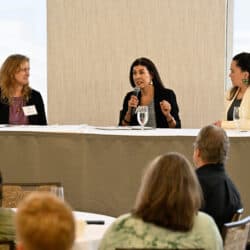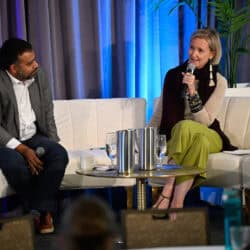Funders and conference speakers say they’ll be highlighting non-qualified donees, participatory grantmaking, and youth-led organizing as fundamental to working in philanthropy today at Philanthropic Foundations Canada’s 25th-anniversary gathering.
This week, Philanthropic Foundations Canada (PFC) – a national network whose members span private and public foundations, charities, non-profits, and corporate giving programs – is hosting the Together 25 Ensemble. The 400-plus conference attendees will join educational sessions across three streams: fundamentals, trends and tensions, and collaboration.
The fundamentals stream focuses on making governance, grantmaking, investing, government relations, and equity more accessible to philanthropic professionals, whether their organizations are in their first or 40th year.
Indigenous-led philanthropy: Northern perspectives
The vice-chair of the board of Nunavut’s first community foundation, the Annauma Community Foundation, will be presenting on how Indigenous culture directly shapes Annauma’s philanthropic approaches. Short for the Inuktitut word “Annaumakkaijiit,” “Annauma” means “helping people stay ahead.” Executive director Danielle Gibbie explains that “there’s a[n] [Inuit] perspective that Inuit are only as strong as our weakest members, and the communal means of preparedness and resourcefulness is still really relevant in culture today.”
There’s a perspective that Inuit are only as strong as our weakest members, and the communal means of preparedness and resourcefulness is still really relevant.
Danielle Gibbie, Annauma Community Foundation
Annauma provides grants through a consensus-based decision-making model, bringing cohorts of organizations and participants together to share their projects, initiatives, and funding allocations. Gibbie uses the example of Inuit gathering for a feast to describe how Annauma’s partners often come to decisions. “When they’re gathering over a feast, whether that’s seal or caribou, you wouldn’t cut that and divide it into equal pieces. People only take what they need, and that’s what we see in how the funding allocations are done,” she says. “We’ve seen it in every single cohort, where organizations will scale down their project and tell another organization that they should have money, they should have more support to make sure that their project is supported and they can do what they want.”
Gibbie says that Nunavut has only 37 registered charities but more than 200 non-profits, so Annauma has been granting to non-qualified donees and recognizes the need to strengthen their capacity.
Granting to non-qualified donees: What you need to know
The recent CRA changes around how foundations can grant to non-qualified donees have many foundations seeking advice from practitioners and legal experts. A session moderated by Sebastian Muermann, grants and learning manager at Chamandy Foundation, will help organizations understand what they have a “green light” to do so they can “move forward without doing something wrong,” he says.
I’m hopeful that the new CRA guidelines . . . allow for partnership to exist in an unrestricted way.
Sebastian Muermann, Chamandy Foundation
Muermann says that organizations are ready to do their due diligence to verify where they are granting money and hopes the CRA will provide new guidelines that will add clarity around audited financials and different requirements for partnering as trust-based philanthropy practices move away from direction and control. “I’m hopeful that the new guidelines by the CRA are still in that spirit, and allow for partnership to exist in an unrestricted way,” he says. “Because if we are required to ask for way too much information from our non-qualified donee partners . . . that’s not in the spirit of why we moved towards [trust-based philanthropy].”
When The Philanthropist Journal inquired about additional guidelines to clarify how organizations can partner with non-qualified donees, CRA senior project officer Nina Ioussoupova noted in an email that the CRA has published an explanatory guideline with examples to illustrate how charities can apply them. She also said that members of the public can comment or provide suggestions to the CRA.
Grantmaking practices: Trust-based and participatory
Rooting their philanthropy in community support, Concordia University’s SHIFT Centre for Social Transformation approaches collaboration with existing and emerging transformation initiatives based in Montreal by facilitating participatory grantmaking and providing capacity- and strategy-building resources. SHIFT operates with a shared power model in which its steering committee, consisting of Concordia and SHIFT community members, decides how SHIFT operates, while its selection community is recruited by Concordia University and SHIFT’s community partners. No selection committees are the same for funding decisions.
Our goal is fundamentally relationship-building that is more holistic, wrap-around, and multi-pillared.
Richenda Grazette, SHIFT Centre for Social Transformation
“Breaking outside of the echo chamber does mean bringing in traditionally marginalized voices, but it also means more to us: fostering unlikely allyships and convening people across power differentials,” says Richenda Grazette, SHIFT’s funding and evaluation coordinator. She notes that SHIFT is not strictly a philanthropic body. “Our goal is fundamentally relationship-building that is more holistic, wrap-around, and multi-pillared.”
In addition to its participatory grantmaking, SHIFT connects both recipients and partners who do not receive funding to university event spaces, internship programs, and research collaborations, while staff provide support organizations with training and strategy needs. SHIFT is also a campus co-working space.
“We see granting as like a gateway into our ecosystems,” Grazette says.
Approaches to supporting youth and young adults in our communities
Amanda Bernard, director of Laidlaw Foundation’s Indigenous Youth and Community Futures Fund (IYCFF), will join other youth-supporting organizations for this session. She observes that many adults try to lead the youth groups they are supposed to help. “I think I would like to see more people open to the flexibility of working with youth and giving them more authority or space to decide on how they want to approach the problem,” she says. “Youth-serving is different than youth-leading.”
The IYCFF provides funding for Indigenous youth-led groups to develop and lead immersive projects that focus on their connections to their lands, languages, and culture while building relationships with other Indigenous communities. The successful grants are decided by Laidlaw’s youth advisory committee, which consists of six Indigenous youth. The IYCFF gives successful recipients the money upfront to use to build capacity for themselves. Workshops, conferences, communication, story-building, and website design are some of the areas she says the youth could need money for. “We’re just very flexible and want to support the youth as best as we can, but also make sure that we’re not overpowering them.”
We want to support the youth as best as we can, but also make sure that we’re not overpowering them.
Amanda Bernard, Laidlaw Foundation
Bernard says that Laidlaw has also been working on sharing more approaches to decolonizing philanthropy, such as working with non-qualified donees. “I feel like a lot of people have their reservations against working with non-qualified donees. They consider them higher risk, and that’s where actually most of the youth are coming from. They don’t have well-established organizations.” She says that ultimately, grassroots groups want to solve a problem in the community, so she hopes more organizations will adapt Laidlaw’s processes and start funding non-qualified donees to engage with youth. “I wouldn’t consider them high risk. I think any organization is almost equally as risky. [There] really is an onus on the organization or foundation to do their due diligence.”
Changing the fundamentals
Practising philanthropy through the lens of Indigenous culture; prioritizing partnerships with unincorporated, non-qualified donees amidst federal tax regulations; insisting on youth leaders’ agency – these original and emerging philanthropic principles are not mandated Canadian philanthropic practices. Despite this, these organizations, varying in size, mission, and cultural leadership, are demonstrating how historic and emerging values are establishing preferred fundamentals for their philanthropic activity and communities’ interests.


